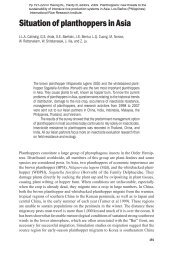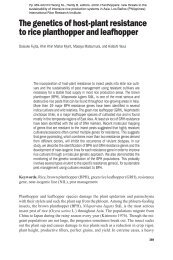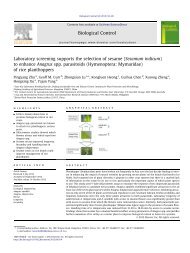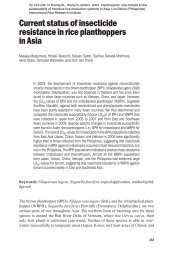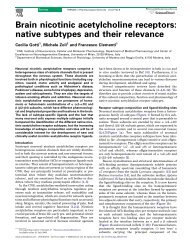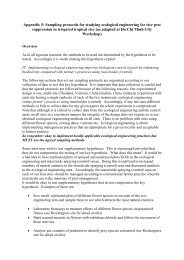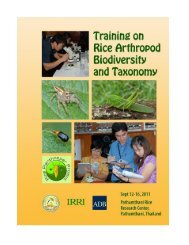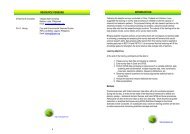Chen, Yolanda et al. 2011. Planthopper âadaptationâ - Ricehoppers
Chen, Yolanda et al. 2011. Planthopper âadaptationâ - Ricehoppers
Chen, Yolanda et al. 2011. Planthopper âadaptationâ - Ricehoppers
Create successful ePaper yourself
Turn your PDF publications into a flip-book with our unique Google optimized e-Paper software.
Author's person<strong>al</strong> copy<br />
Y.H. <strong>Chen</strong> <strong>et</strong> <strong>al</strong>. / Journ<strong>al</strong> of Insect Physiology 57 (2011) 1375–1384 1377<br />
negatively impacting the planthoppers (Noda, 1974; Wilkinson<br />
and Ishikawa, 2001). YLS are associated with planthoppers at every<br />
stage of development, and are YLS are transmitted to the subsequent<br />
generation through transovari<strong>al</strong> transmission. While the<br />
heat treatment does not compl<strong>et</strong>ely remove the YLS, heat-treated<br />
planthoppers contain 5% of the YLS abundance levels of untreated<br />
planthoppers (<strong>Chen</strong> <strong>et</strong> <strong>al</strong>., 1981). Given that YLS could not be removed<br />
compl<strong>et</strong>ely, the YLS remov<strong>al</strong> treatment was conducted separately<br />
for each generation studied. In this study, we use the term<br />
‘‘aposymbiotic’’ to denote planthoppers that have been exposed to<br />
the heat treatment for three days after hatching.<br />
Following Noda and Saito (1979), YLS-depl<strong>et</strong>ed insects were<br />
generated by rearing newly-hatched planthoppers on the three<br />
treatment vari<strong>et</strong>ies at 35 °C for 3 days in a growth chamber, and<br />
<strong>al</strong>l symbiotic and YLS-depl<strong>et</strong>ed planthoppers were held at 25 °C<br />
(12:12 L:D) for the remaining 5 days. In order to quantify wh<strong>et</strong>her<br />
the heat treatments reduced YLS abundance, planthoppers from<br />
each of plant were immediately frozen at 80 °C. Each replicate<br />
consisted of six planthoppers ground up in 200 ll of s<strong>al</strong>ine solution,<br />
and 16 replicates were compl<strong>et</strong>ed for each rice vari<strong>et</strong>y. A<br />
2 ll drop of the planthopper suspension was added to a hemocytom<strong>et</strong>er,<br />
and the number of YLS was counted under a compound<br />
microscope. Each cell was equiv<strong>al</strong>ent to 0.1 ll. We tested if the<br />
heat treatment or rice vari<strong>et</strong>y influenced YLS abundance in twoway<br />
ANOVA. While the rice vari<strong>et</strong>y did not influence YLS abundance,<br />
we observed that the heat treatment resulted in a 90%<br />
reduction in YLS abundance (1688.95 ± 85.01 YLS/ll vs.<br />
168.33 ± 10.98/ll; t = 17.74, df = 94, P < 0.0001).<br />
2.3. <strong>Planthopper</strong> development<br />
Ten newly-emerged nymphs were placed onto each of six treatment<br />
plants (TN1, Mudgo, and ASD7), for a starting population of<br />
60 nymphs per treatment. Symbiotic planthoppers were held on<br />
the treatment plants at 25 °C, while YLS-depl<strong>et</strong>ed planthoppers<br />
were created by holding planthoppers on treatment plants at<br />
35 °C for 3 days. After the heat exposure, <strong>al</strong>l plants were held at<br />
25 °C for an addition<strong>al</strong> 5 days. Surviving planthoppers were<br />
weighed individu<strong>al</strong>ly on a microb<strong>al</strong>ance with a sensitivity of<br />
0.01 mg (Sartorius ME0215S). The procedure was repeated using<br />
planthoppers collected from the 8th and 11th generations.<br />
2.4. Tot<strong>al</strong> nitrogen an<strong>al</strong>ysis<br />
We tested if tot<strong>al</strong> nitrogen varied among the planthoppers from<br />
the different treatments. We placed 50 N. lugens nymphs on each of<br />
25 treatment plants, following the full factori<strong>al</strong> design (3 nat<strong>al</strong><br />
vari<strong>et</strong>ies 3 exposed vari<strong>et</strong>ies YLS presence), for a tot<strong>al</strong> of 18<br />
treatment combinations. Due to the high number of individu<strong>al</strong>s<br />
(22,500) needed for each replicate; we compl<strong>et</strong>ed three replicates<br />
of the full factori<strong>al</strong> design tempor<strong>al</strong>ly. Therefore, each replicate<br />
consisted of a separate planthopper generation. Nymphs were<br />
reared for 8 days, and surviving insects were dried at 80 °C for<br />
24 h, weighed (Sartorius BP110S, 0.1 mg sensitivity), and pooled<br />
to generate enough sample for the an<strong>al</strong>ysis. A minimum of 5 mg<br />
of dried planthopper materi<strong>al</strong> was required by the An<strong>al</strong>ytic<strong>al</strong> Service<br />
Laboratory (ASL) at IRRI for the tot<strong>al</strong> nitrogen an<strong>al</strong>ysis, which<br />
ranged from 165 to 996 individu<strong>al</strong>s for each treatment. Dried<br />
planthoppers were finely ground, and 2.5 mg were used to quantify<br />
tot<strong>al</strong> N on a Thermo Scientific FlashEA 1112 nitrogen and carbon<br />
an<strong>al</strong>yzer, previously c<strong>al</strong>ibrated using known standards.<br />
2.5. <strong>Planthopper</strong> amino acid an<strong>al</strong>ysis<br />
The hydrolyzed amino acid content of the planthoppers was<br />
d<strong>et</strong>ermined using reverse-phase high performance liquid chromatography<br />
(HPLC). In order to standardize nymph<strong>al</strong> age, 100 gravid<br />
fem<strong>al</strong>e adults were introduced into a cage with TN1, Mudgo, and<br />
ASD7 plants to lay eggs for 12 h. We placed five newly-emerged<br />
planthopper nymphs onto individu<strong>al</strong> 30 day-old TN1, Mudgo, or<br />
ASD7 plants, a density lower than the economic injury level (Heinrichs<br />
<strong>et</strong> <strong>al</strong>., 1985). The number of treatment plants varied because<br />
the number of planthopper nymphs needed for 2 mg of sample<br />
varied. <strong>Planthopper</strong>s were randomly designated for the YLS-remov<strong>al</strong><br />
treatments. After exposure to heat treatment for 3 days,<br />
<strong>al</strong>l treatment plants were placed in a growth chamber at 25 °C<br />
for an addition<strong>al</strong> 5 days, after which surviving insects were immediately<br />
frozen at 80 °C. The study was repeated using the 6th and<br />
8th planthopper colony generations.<br />
Each replicate consisted of 2 mg of frozen planthoppers collected<br />
from each treatment. The number of planthoppers required<br />
ranged from 8 to 16 individu<strong>al</strong>s per replicate. <strong>Planthopper</strong>s were<br />
homogenized with 100 ll ice-cold 80% m<strong>et</strong>hanol, and the homogenate<br />
was centrifuged for 20 min at 15000g. The supernatant was<br />
removed, and the remaining sample was vacuum-dried, hydrolyzed<br />
with 100 ml of constant boiling hydrochloric acid and 1 mg<br />
phenol. The insect protein were transferred into borosilicate V-<br />
vi<strong>al</strong>s, purged of oxygen with nitrogen gas and se<strong>al</strong>ed immediately<br />
by lining the vi<strong>al</strong>s with Teflon tape before replacing the cap. The<br />
sample was dried in an oven at 110 °C for 20 h. Nanopore water<br />
was added to the hydrolysate to reach 1 ml, and then passed<br />
through a 0.22 l filter.<br />
Twenty microliter of the filtered hydrolysate was vacuumdried,<br />
then reconstituted with 10 ll of 20 mM constant boiling<br />
HCl. The reconstituted sample was derivatized with the AccQ-Fluor<br />
reagent kit (WAT052880-Waters Corporation, Milton, MA, USA).<br />
Using a micropip<strong>et</strong>ter, 70 ll of AccQ-Fluor borate buffer was added<br />
in the sample tube and vortexed briefly. We then added 20 ll of<br />
AccQ-Fluor reagent and vortexed the sample immediately for sever<strong>al</strong><br />
seconds. After 1 min, the contents were transferred to an autosampler<br />
vi<strong>al</strong> with a low volume insert and capped with a siliconelined<br />
septum. The vi<strong>al</strong> was heated for 10 min in a waterbath at<br />
55 °C before HPLC separation.<br />
The AccQ-Fluor amino acid derivatives were separated on a<br />
Waters 2695 Separations Module HPLC System attached to a<br />
Waters 2996 Photodiode Array D<strong>et</strong>ector. A 5 ll sample was injected<br />
into a Waters Nova-Pak C 18 Silica-bonded Column<br />
(150 mm 3.9 mm). The Waters AccQ Tag Eluent A Concentrate<br />
was used as eluent A (WAT052890) and 60% ac<strong>et</strong>onitrile as eluent<br />
B in a separation gradient (Appendix).<br />
The amino acids were d<strong>et</strong>ected using a Waters Photodiode Array<br />
D<strong>et</strong>ector (Model PDA 2996, Waters Corporation) with the column<br />
condition s<strong>et</strong> at 37 °C. The amino acid peaks were acquired<br />
using Empower Photodiode Array (PDA) software by Waters Corporation<br />
(2002) and were c<strong>al</strong>culated based on an amino acid c<strong>al</strong>ibration<br />
standard (PIERCE Amino Acid Standard H, Product No.<br />
20088) run at three concentrations (10, 20, 40 lM). Amino acid<br />
assignments were visu<strong>al</strong>ly checked to verify the peak assignment.<br />
For the amino acid an<strong>al</strong>ysis, we c<strong>al</strong>culated the molar concentration<br />
of the sample, and the proportion<strong>al</strong> molar concentration for each<br />
amino acid. Sample quantities were converted from pmol/ll to<br />
nmol/ml, and then divided by the number of insects found in each<br />
sample. Therefore, the data are shown as the average hydrolyzed<br />
molar concentration of the amino acids per insect.<br />
2.6. Statistic<strong>al</strong> an<strong>al</strong>ysis<br />
We used a mixed-effects ANOVA to test the effect of the nat<strong>al</strong><br />
host plant, exposed plant, generation, YLS presence and <strong>al</strong>l possible<br />
interactions on planthopper nymph<strong>al</strong> weights in JMP 7.0.1 (SAS<br />
Institute, Cary, NC). We designated the nat<strong>al</strong> and exposed host<br />
plant treatments as fixed effects, and generation and YLS presence



